TECH TALK: All About… Clutch Technology
Modern Driveline shows you how to choose the right clutch
Although clutch and flywheel selection seems like black magic science, it really is straightforward. When the right choices are made you get an unbeatable clutch and flywheel combo that will serve you well for years to come. In the long run, you will save a bunch of money with the right decision, to begin with. And can you afford to make a bad decision?
Think about it…
Karl Benz is generally recognized as the father of the automotive clutch, which was invented nearly a century ago. There have been many variations of the humble hard-working clutch in the years since. The clutch’s primary task is to transmit power from the engine’s crankshaft to the transmission smoothly and firmly without slippage. Some slippage is important for smooth engagement, without excessive slippage that will cause unnecessary wear and heat issues. You want reasonable pedal effort yet solid engagement, which is what you will get from our Superior clutches.
Clutch selection depends upon the kind of driving you intend to do. If you’re going cruising or doing the workday commute, you need a high-quality diaphragm style single disc organic clutch. Organic clutch frictions provide smooth engagement and longevity in street use. Weekend racing calls for a Kevlar/organic combination. And if you’re really serious about performance driving, a Kevlar high-performance clutch is what you’re going to need to meet the demand.
Clutch Types
There are two basic types of clutches — diaphragm and Long style. The Long Style three-finger clutch was original equipment in a lot of vintage applications. Because the three-finger clutch and pressure plate exert incredible amounts of pressure they also create tremendous amounts of clutch pedal effort. Back in the day, a stiff clutch pedal was the norm, but not anymore. Clutch technology has since become such that you don’t have to put up with a stiff clutch pedal (or the resulting knee replacement surgery) anymore. We can’t think of any reason here at Modern Driveline why you should have to put up with a heavy-handed clutch pedal.
The Long Style clutch consists of:
- Pressure Plate Cover
- Pressure Plate or Head
- Fingers or Levers
- Fulcrum Pins
- Coil Springs
- Clutch Disc or Friction
Now that’s a lot of parts!
The Long style three-finger clutch exerts brute pressure on the disc via a series of coil springs between the cover and plate. Spring pressure is the same regardless of engine rpm. Pedal effort is also the same regardless of engine speed. The Long Style clutch is an archaic design at best. It doesn’t make sense to use one anymore.
Diaphragm Style Clutches
Diaphragm style clutches, as the name implies, consist of a diaphragm spring that “oil cans” between engaged and disengaged. It is easy to depress yet it delivers whopping hold power. The advantage of a diaphragm clutch is greater clamping power than a conventional three-finger Long style clutch yet without high pedal effort. What’s more, as diaphragm clutch discs wear clamping power increases over the life of the clutch, which improves clutch performance.
This is one of the great advantages of a diaphragm-style clutch. Another advantage is pedal effort, which is considerably less than a Long style clutch.
Although there are a lot of diaphragm style clutches in the marketplace Modern Driveline brings you a better clutch and here’s why. Modern Driveline brings you a greater selection with a complete line of clutches and flywheels from the most trusted names in the industry — Superior, and McLeod. We enjoy an extraordinary relationship with Superior Clutch because each clutch is handcrafted for Modern Driveline. Each Superior clutch goes through rigorous testing throughout the manufacturing and quality assurance process resulting in high reliability and performance.
A lot of manufacturers talk about Kevlar clutch frictions, yet in truth, their clutch discs contain a very modest amount of Kevlar — some 10-20-percent — which isn’t saying much. Superior Clutch’s discs are nearly 100-percent Kevlar, which can stand extreme punishment and come back for more as hard miles are driven. If you’re a civilized driver your Superior Kevlar clutch from Modern Driveline may well be the last clutch you ever buy. They’re that good.
Clutch, Need To Know
We can get into a lot of clutch science and physics. However, here’s what you need to know in order to make an educated purchase.
There are three Modern Driveline clutch discs from Superior Clutch for your consideration — Organic, Kevlar/Organic, and Kevlar/Kevlar.
The Superior Organic clutch from Modern Driveline is a basic stock replacement in either 10″ or 10.5″ and with either a standard pressure plate or the brute King Cobra pressure plate. The Superior clutch is economical and well suited to the daily/weekend driver or show car. The Superior Super King Cobra clutch from Modern Driveline features steel-backed facings to prevent disc separation common with King Cobra clutches and heavy abuse.
Modern Driveline’s Superior Kevlar/Organic clutch is a multi-friction type with Kevlar® and Organic surfaces designed for additional grip in mind and high heat tolerance from high-performance applications. These clutches are available in 10″ or 10.5″. The Superior Kevlar/Organic clutch is optimum for street and track use.
Superior Clutch’s Kevlar/Kevlar clutch from Modern Driveline is designed for long life and minimal wear under extreme duty conditions. These heavy-duty clutches available in 10.5” are preferable for high-performance, high torque applications. What’s more, they’re preferable for lightweight vehicles prone to clutch chatter.

Side by side is the two basic types of clutches — diaphragm (left) and Long style (right).
By design three-finger, Long style clutches yield a very stiff clutch pedal.
Diaphragm-style clutches provide a powerful grip without a stiff clutch pedal.
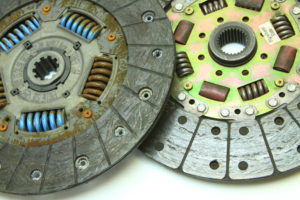
Two organic clutch discs — coarse tooth (left) and fine-tooth (right).
Clutch discs are generally designed for application (size and transmission input shaft) the type of use they will experience.
Organic clutch frictions are for mild street use.


Here’s why the Long style three-finger clutch gives us such a stiff pedal — powerful springs that provide exceptional holding power.
However, they also make it very hard on your left leg and mechanicals because pressure plate holding pressure is transmitted directly to the clutch pedal linkage.
This really is an outdated clutch design when there’s a better choice.

The diaphragm clutch is simply a better piece by design because it gives us great holding power without a stiff pedal.
This is a small light-duty diaphragm pressure plate.


Here are another larger diaphragm clutch and disc for GM applications with a fine-tooth clutch disc.

The beauty of the diaphragm clutch is simplicity — fewer parts. This link ties the pressure head to the backing plate.

These coil springs act as shock absorbers in a clutch disc.
This is what gives us a smoother engagement as the clutch disc and pressure plate take hold.
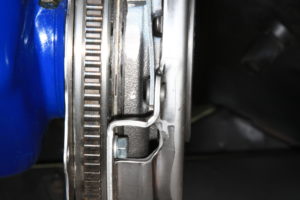
Diaphragm clutch fully engaged with clutch disc compressed.
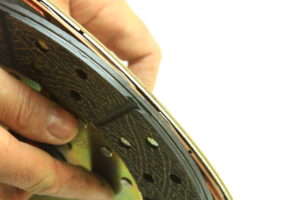
Organic and Kevlar clutch discs back to back. On the left is the organic friction disc, which is thicker and heavier.
On the right is the lighter and tougher Kevlar disc.
Superior Kevlar discs are nearly 100-percent Kevlar designed to take the extremes of racing. Organic discs are strictly for street use.
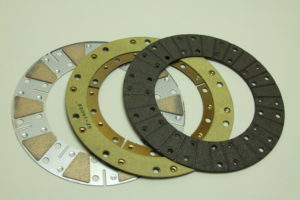
From left to right are metallic, Kevlar, and Organic discs

Here’s the Superior diaphragm clutch with organic friction for street use.
The organic disc will not stand up to the punishment associated with racing.
This is a coarse tooth hub for vintage Ford applications.

This is a Kevlar clutch friction in fine-tooth for GM applications.
A fine-tooth hub provides greater strength because there are more shaft and hub surface areas.
Kevlar can be used for street and strip, however, it is primarily a racing clutch. It can take tremendous punishment and come back for more.

Here’s a closer look at the Kevlar surface. All of our Superior Kevlar clutches are nearly 100-percent Kevlar for extraordinary durability and long life.
Kevlar doesn’t look all that intimidating but don’t let looks deceive you. Kevlar is the toughest clutch material available.
If you buy it for street use you will never have to buy another clutch.
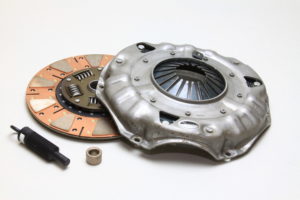

Here’s a metallic Superior clutch for all-out racing applications. This pressure plate is for GM products.
As a rule, most GM applications employ a fine-tooth input shaft.

We also stock McLeod dual-friction diaphragm style clutches for performance applications.
The choice depends upon how much power you have and what you want your vehicle to do.

Here are the input shaft types you can expect to see for domestic applications.
These are clutch alignment tools.
Two from clutch kits and one copped from a Ford transmission.
The steel input shaft works well as a clutch alignment tool.
Our Superior clutches come with a clutch alignment tool for your convenience.
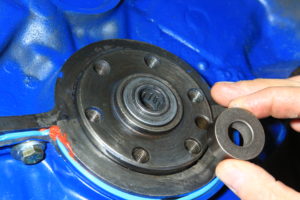
Clutch pilot bushings (right) are typical for OEM installations. Compliment your Modern Driveline clutch installation with a pilot bearing (left) for precision function and smooth clutch operation.
While you have your vehicle apart check the engine oil pan gasket, rear main seal, and transmission input shaft seal for any leakage.
Any leakage issues must be handled at this time or you wind up with clutch disc contamination.
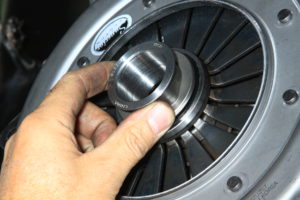
Clutch release bearing to diaphragm alignment must be spot on for proper function and longevity.
Diaphragm style clutch release bearings are constant duty parts meaning they’re in contact with the diaphragm at all times.

Compliment your new Superior clutch installation with a new flywheel from Modern Driveline.
This is money well spent because every new clutch deserves a new flywheel surface.
We stock steel, billet, and aluminum flywheels for nearly every application imaginable.
Call Us if you have questions… 208-453-9800
Please log in to leave a comment.

No Comments Yet